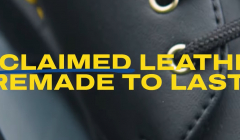
Dr. Martens champions sustainable fashion
Genix Nappa, a new material made of leather offcuts, aims to reduce waste

Nic Alford warns against the use of stereotypes when it comes to LGBTQ+ representation

I don’t design posters, I don’t develop strategic or creative concepts, but I am a consumer and I do have opinions. I also head up the Pride Committee at MullenLowe Group UK, an integrated advertising agency based in Shoreditch, which is why I leapt at this opportunity to share my thoughts on LGBTQ+ representation in advertising.
Advertising can shape and influence the way people see the world. It has the power to empower people to be proud of their sexuality and not hide it. It’s a shame to see that according to Simpson Carpenter’s Diversity Matters research, 31% of the LGBTQ+ population feel that the ad industry is portraying them badly, and 57% of queer individuals agree with the statement “I don’t see my lifestyle represented in advertising”. It’s clear we need to do better in making sure that more of society feels included.
But how do we include society authentically, represent something which is so often not visible, and without tokenising allyship?
My view on queer representation, and representation of other minority groups, is that ultimately, we are just people. We come in all shapes and sizes, with different experiences, we have stories; we’re not storylines.
When brands use stereotypical queer experiences to highlight differences in our society, it does just that. It creates a divide. Inclusion is a result of being inclusive, so let’s normalise diversity without it being the entire storyline of the advert. Although not an advert, Jackson’s parents in Sex Education would be a good example of this because their sexuality is not the storyline, it’s just their life. And let’s not just normalise diversity around sexuality, but also in race, gender, age, and (dis)ability. You only have to hear Caitlin Moran’s recent comments at the Creative Equals RISE conference to know that there are still women who don’t relate to women in ads.
We come in all shapes and sizes, with different experiences, we have stories; we’re not storylines
Nic Alford, Head of Pride Committee & Senior New Business & Marketing Executive, MullenLowe Group UK
In my opinion, successful brand campaigns aren’t those that highlight sexuality or use it as the key message, but those that have authentic everyday narratives for example our BUPA ‘Is it normal?’ campaign which features a man getting a tattoo, who has top-surgery scars. You can ensure authenticity by bringing these experiences into the conversation. Not just in casting, which is a point in itself, for example Zebedee Talent is driving the agenda in inclusive representation in high fashion. But also behind the camera, in the development of strategies, throughout the creative, even in boardrooms. It all matters and it all counts. I know The Elephant Room has built their whole business model around this, where they drive inclusion through non-traditional talent. Which makes sense - the wider industry should be doing the same.
A brand’s commitment to supporting LGBTQ+ people should be seen across all channels. Take time to consider how your brand values will translate from TV ads to social, print, or experiential. If a brand’s Instagram has no reference to inclusion or engagement with queer people, it’s likely I’ll buy something from somewhere else that does. And I’m not alone in this. Think with Google found that 45% of consumers under the age of 34 say they are more likely to do repeat business with an LGBTQ+ friendly business, and 82% of allies are more likely to engage with a brand that supported LGBTQ+ equality.
Don’t let fear or nervousness stop you. Bring our community into the conversation. Let the Pride committee within your agencies or businesses inform your brand positioning, and you can be confident that your approach will be authentic. As ESG is now an integral part of brand and business planning, don’t forget that equal rights and inclusion are included in that; Environmental, Social, Governance. If you don’t have a Pride committee, how are you ensuring that your queer colleagues are safe and supported? If you don’t have queer colleagues, well then you have a bigger issue to address.
Look at Harry’s ‘Shave with Pride’ sets where £10 from every sale goes to akt – who also happen to be MullenLowe’s chosen charity for 2022. Or Renault’s ‘30 Years in the Making’. Or Skittles enlisting LGBTQ+ artists to create Pride 2022 packaging. These are campaigns that have style and substance.
Ask your friends, pay queer speakers, hire queer talent. Turn up for us, support us, champion us.
You have the power to drive change. Rainbow flags, pronouns in signatures, and gender-neutral toilets are all great steps. But you can go further; this Pride month stop and think about where you can increase your inclusion of the LGBTQ+ community. I recently sat in on a briefing for a period product, where the team made sure to speak with the trans community about their experiences of bleeding, so we can ensure that their voices are reflected in the ads that we produce.
Be creative. Sexuality isn’t easy to represent. Please try not to fall into obvious stereotypes either. Gay men aren’t all effeminate, lesbians aren’t all butch, and coming out is not always a happy teary hug from your parents. Stories, not storylines, remember?
My final ask is to please be kind. Always. And be brave - it can take a lot to accept yourself, but it shouldn't take a lot to accept – or represent - someone else.

Nic Alford, Head of Pride Committee & Senior New Business & Marketing Executive, MullenLowe Group UK
Looks like you need to create a Creativebrief account to perform this action.
Create account Sign inLooks like you need to create a Creativebrief account to perform this action.
Create account Sign in